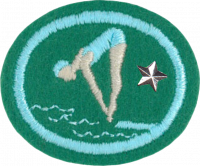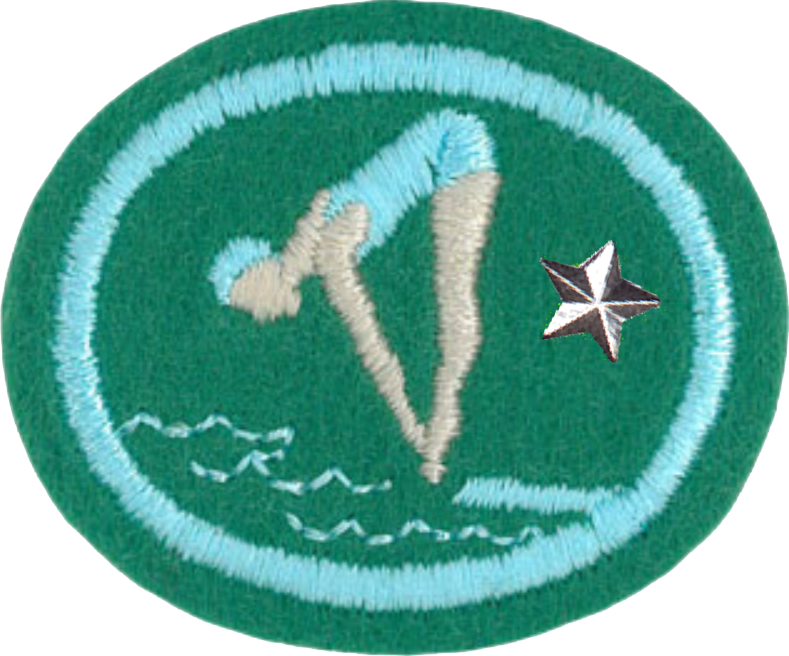AY Honor Swimming - Advanced Answer Key
1
1a
On the back, frog kick with “T” to statue arm movement.
1b
On stomach, simultaneous kick and arm motion. Frog kick to glide with arms down pulling down the body in a sweeping motion to slightly in front of body. During the load-up, arms extend fully to the front and legs spreading for next push to glide. Utilize proper bobbing of the head under the water and rotational breathing.
1c
As best as I (a recreational swimmer) can tell, this is an elementary backstroke with a whip kick (tuck/knees-pointed-up frog kick) rather than a knees-wide frog kick.
1d
Scissor kick with extension movements on the swimmer’s side. The face stays out of the water.
1e
Scissor kick with half-freestyle movements and rotational breathing. Rotate from side stroke as if to transition to freestyle but conclude the stroke back on the side for the glide. Utilize rotational breathing.
1f
Scissor kick with freestyle arm movements and rotational breathing. Arm pull should synchronize with the scissor kick.
1g
Flutter kick with arms rotating up and out of the water to reset and push the water past the body with the hands.
1h
The is the front crawl, better known competitively as the freestyle stroke. Utilize proper rotational breathing.
2
2a
From dock or side of pool into water at a minimum of 9 feet (3 meters) deep. Must be done in good and proper form.
2b
From dock or side of pool into water at a minimum of 9 feet (3 meters) deep. Push out and away from the edge. Must be done in good and proper form.
2c
Must be done in good and proper form.
From treading water, preform a kick with the legs and arms from a “T” to a streamline by your side to push partially out of the water for a breath. After an adequate breath: bend at the hips, keeping the legs strait, reach down with your hands and head towards the bottom of the pool. Keep the feet together with toes pointed completely through the decent. After the initial glide downward, use the arms to displace the water and dive deeper. Keeping the legs strait and the body in a vertical position will help push you down into the water.
2d
Must be done in good and proper form.
From treading water, preform a kick with the legs and arms from a “T” to a streamline by your side to push partially out of the water for a breath. After an adequate breath: reach down with your hands and head towards the bottom of the pool. As you begin to rotate bend at the hips and allow your knees to come towards your chest in a tuck position for easier rotation. Once facing down, straighten the body into an inverted vertical position. After the initial glide downward, use the arms to displace the water and dive deeper. Keeping the legs strait and the body in a vertical position will help push you down into the water.
3
This can be done either on stomach or back with minimal water treading. (On back is easier.)
4
Survival stroke does not require long distances, but staying afloat and moving in a direction. Utilize one of the strokes learned to continuously swim for 10 minutes while fully clothed.
5
The swimmer should not utilize the sides or bottom of the pool.
6
Tips: This requirement does not specify the type of stroke nor a minimum distance. Take your time and utilize different strokes. If one gets more tiring, switch to one more relaxing for you. Set a good slow-steady pace for continuous swimming. Common strokes to use (most to least): freestyle/front crawl, breaststroke, side stroke, elementary backstroke.
7
Failure to pay attention and horseplay are the main causes of accidents around water. Consuming alcohol and drugs (which no Pathfinder would do), or swimming while on relaxant medication (pain relief, etc) causes most of the rest of the accidents. See the Basic Water Safety Honor for more details.
- Learn to swim before you go into the water. Sounds silly, but many people think it will come naturally, and it really doesn’t.
- Make sure that you are safe to swim. (Safe from currents/tides, during the daytime, safe water conditions, not over tired, didn’t just eat to avoid cramping/sickness, etc.)
- Swim near a lifeguard so help is available if you need it.
- Never swim alone, have at least one adult actively watching all swimmers from the side of the pool, dock, boat, or shore.
- Supervise all children closely, even when lifeguards are present, regardless of skill level.
- Don't rely on flotation devices, such as rafts or floaties, you may lose them in the water.
- Alcohol, drugs, and/or relaxing medications and swimming don't mix.
- Protect your head, neck, and spine by never jumping or diving into unfamiliar waters.
- Never go headfirst into shallow water (less than 9 feet or 3 meters).
- As soon as you believe that you may be in trouble, call or wave for help.
- Follow all facility regulations and lifeguard directions.
- Swim parallel to shore if you wish to swim long distances.
- Stay hydrated, you do not feel the sweat on your body while in the water and can easily become dehydrated leading to heat exhaustion.
- Protect your skin. Use SPF 30+ (minimum) to protect from harmful UV rays that can lead to skin cancer (like Melanoma) over time. Reapply every 90 minutes if in water for any amount of time (120 minutes maximum both in and out of water). Also reduces likelihood of sunburn.


